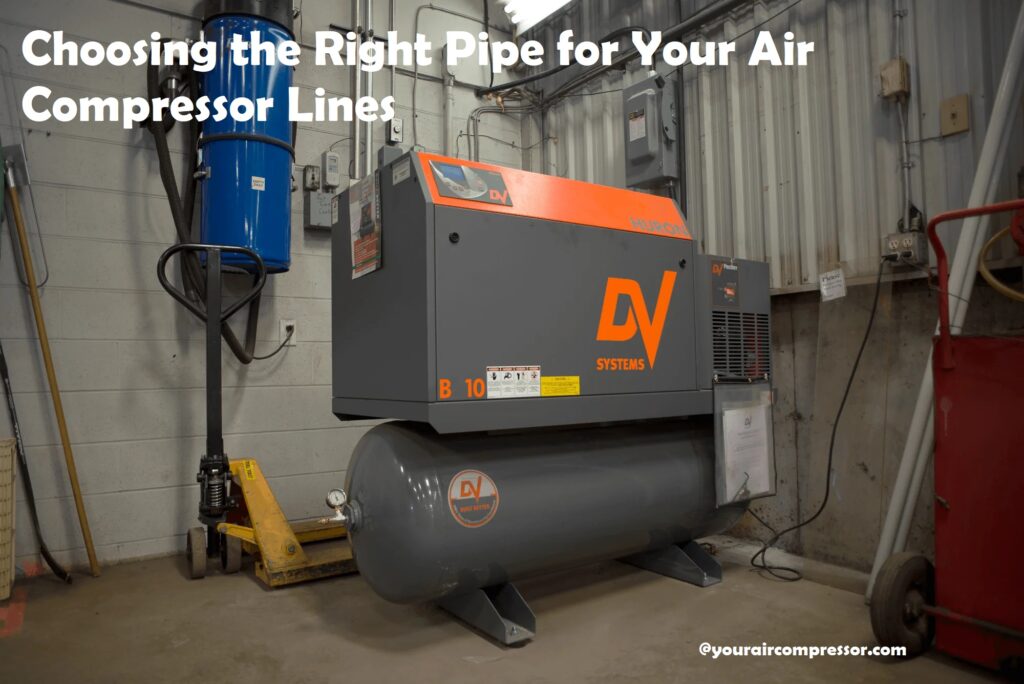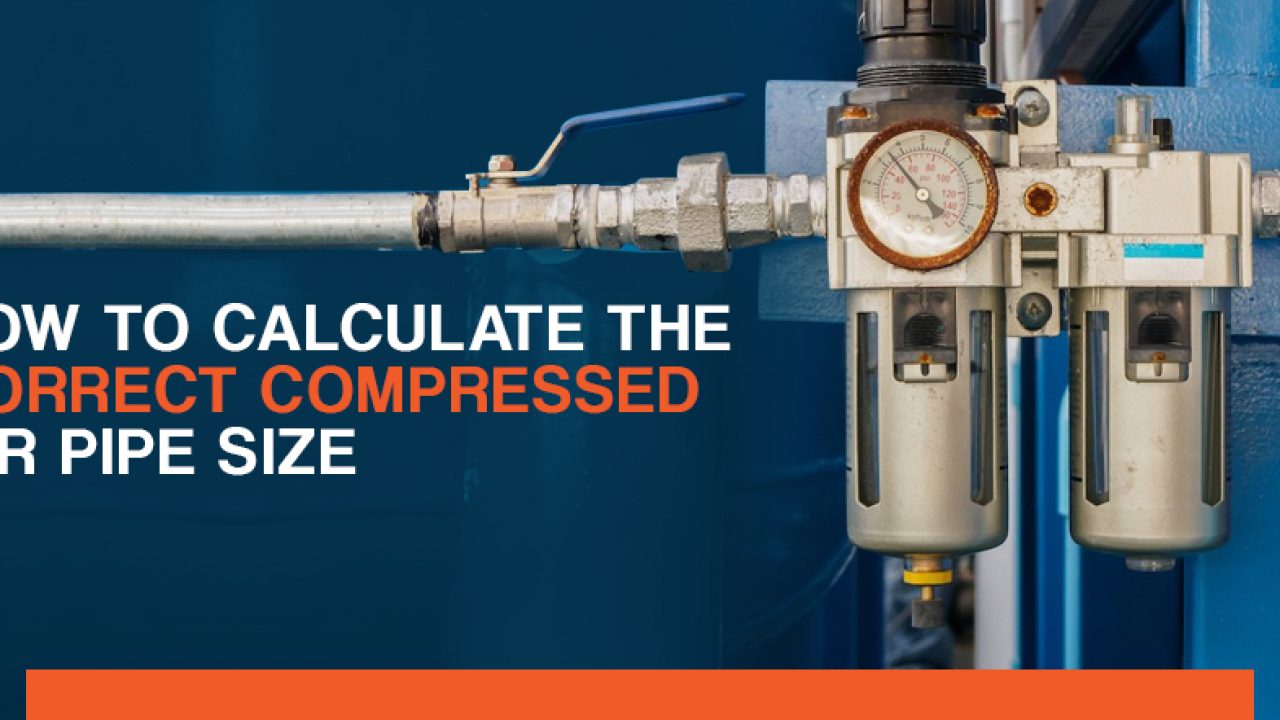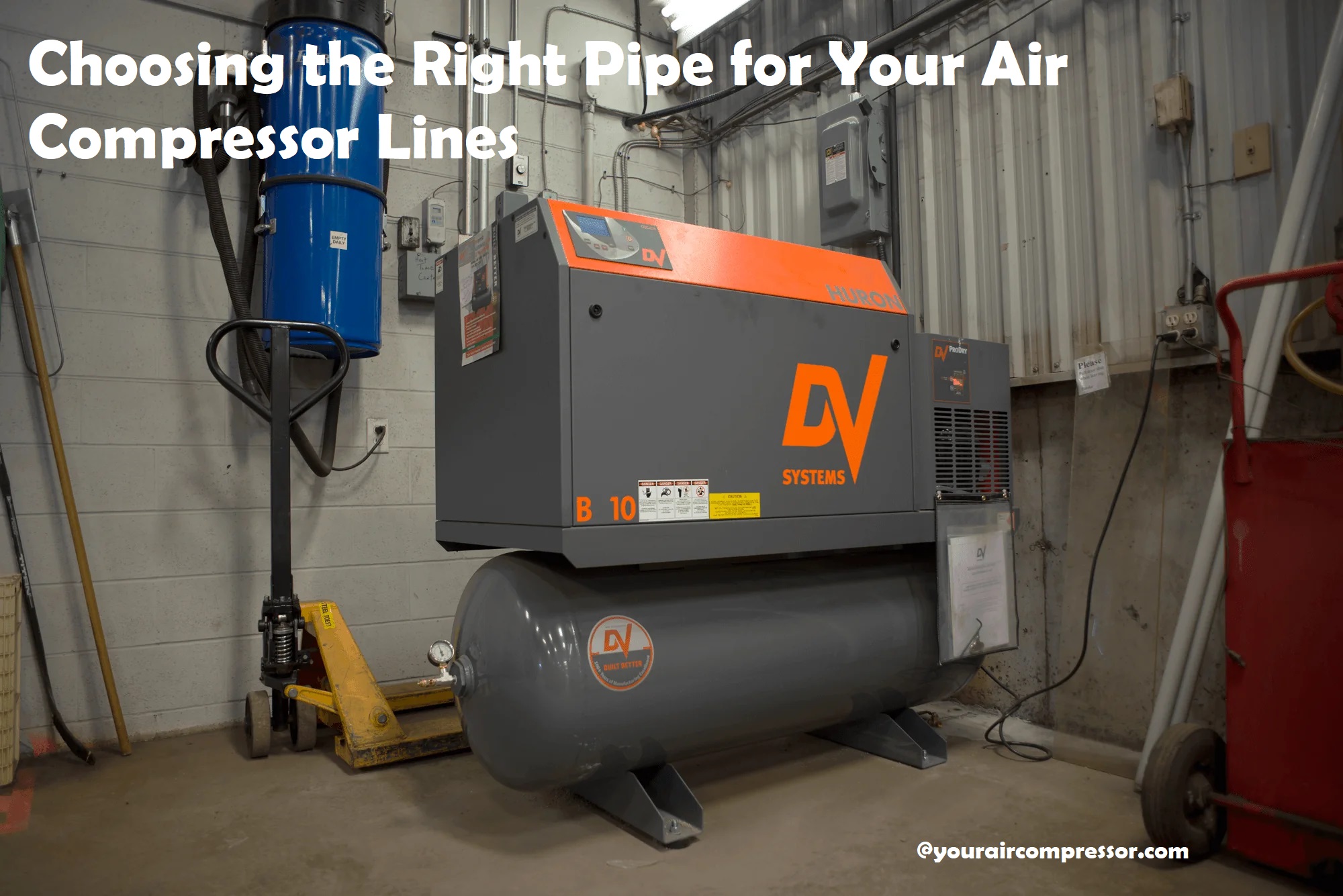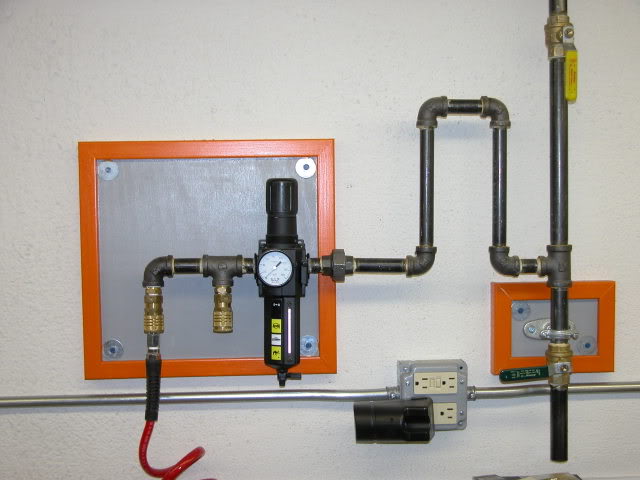Are you struggling with figuring out the right pipe for your air compressor lines? Let us make it easier for you with this comprehensive guide.
Filled with essential tips and useful facts, this guide will help you make an informed and efficient choice.
So, if you’re ready to tackle this problem, let’s get started!
Before we get into the details of choosing the right type of pipe for your air compressor lines, it is important to understand why a pipe is used in the first place. A pipe serves as a channel that allows air to travel more efficiently from the compressor to where it is needed. This can lead to better performance, lower energy costs, and improved safety.
When it comes to choosing a pipe for your air compressor lines, there are several key factors you should consider in order to make sure you select the most appropriate one for your application. In this guide we will cover:
-The different types of pipes available and their advantages -The importance of selecting appropriate pressure ratings for each kind of pipe -Various accessories available for both copper and plastic pipes -Tips on installation and troubleshooting
Importance of choosing the right pipe for air compressor lines
The importance of choosing the right type of pipe for air compressor lines cannot be overemphasized. Choosing the wrong pipe can result in not only wasting resources and money but can also cause health and safety problems, due to the possibility of moisture entering your airflow system. When air passes through metal pipes, some amount of oil and debris is accumulated which may cause clogging or reduces air pressure or flow rate. Improperly sized or poor quality pipes may also create a restriction in your system, which decreases efficiency.
When selecting a pipe for your system, it is important to consider quality, pressure rating, material type and size. Using a proper piping material that is rated for the necessary pressures and temperatures will ensure a safe connection between components and maximize the performance of your compressor or blower system. The quality of pipe affects not only performance but also safety as well as other factors such as corrosion resistance. The type of material used in constructing pipes should be carefully considered to achieve optimal performance while taking into account all operational requirements such as temperature range suitability and chemical compatibility with fluids that might come into contact with it during operation.
Installation guidelines must also be followed when installing these pipes to ensure that they are properly sealed against leaks using gaskets, clamps or flanged connections depending on the characteristics of each component being connected together. To further improve the longevity and performance of these pipelines it is important to use non-metallic materials when available in order to reduce costs while providing superior protection against corrosion caused by moisture build-up within high-pressure systems operating outdoors exposed to weather elements such as salty ocean air, ultraviolet radiation from direct sunlight or intense high temperatures within factories during certain processes & tasks.
Overview of the guide
This guide is designed to provide an in-depth overview of the various types of pipes available for use in air compressor lines. It will walk you through the many factors involved in the selection process, such as material choice, size and configuration.
In addition, this article will discuss some basic installation tips to ensure a successful system installation. By the end of this guide, you should have all the information you need to select and install the right pipe for your air compressor lines.
Types of pipes for air compressor lines
One of the most important aspects when creating an air compressor line is to select the right electric-resistance-welded steel pipe. Depending on the type of air compressor system you are building, there are a variety of pipes that can be used including galvanized pipes and black steel pipes. For certain air compressor systems, other materials such as aluminum or stainless steel may also be used. It is important to understand what each material offers so you can make an informed decision:
Galvanized Pipe: Galvanization is a process that coats a metal such as iron or steel with zinc to protect it from corrosion due to regular exposure to moisture and other elements. Galvanized pipe is widely used for air compressor lines because it is durable and relatively inexpensive.
Black Steel Pipe: Black steel pipe is also often used for making air compressor lines because it does not corrode like galvanized does and has less risk of leaking. It has a smoother interior that helps support high pressure, however black steel pipes require specialized sealants or tape to ensure an adequate seal on threads due to their smooth surfaces.
Aluminum Pipe: Aluminum piping systems have become increasingly popular in residential homes due to their ease of installation; they are lightweight, faster and more efficient overall than other materials. Other advantages include being relatively resistant against chemical reactions with water or air compression fluids, although they require specific aluminum grade alloys in order for them not to corrode over time under certain temperatures and/or pressures in the pipelines.
Stainless Steel Pipe: Stainless Steel offers excellent corrosion resistance properties while being stronger than plastic systems and offering a much better immune system against conductive Joule heating effects (when charging particles coming into contact with electric energy). It conducts well both heat and electricity which makes it ideal for high pressure systems operating under temperature restrictions such as hot water heating schools or boiler rooms where temperatures can be controlled by using specific senses or instrumentations along the pipeline route.
PVC pipes
PVC (polyvinyl chloride) pipes are a popular choice for many air compressor lines. Lightweight and inexpensive, PVC pipes are used for both commercial and residential applications, with sizing ranging from 1/4 inch to 4 inches in diameter. PVC pipes are highly resistant to corrosion and chemical attack, which is why they are commonly used for carrying away wastewater from sinks and other plumbing fixtures.
PVC is also popularly used for air compression lines because it is lightweight and can be connected using a variety of techniques, including threaded connections and solvent welding. For higher pressure systems, it’s necessary to select appropriate pipe size; connecting too large a pipe diameter can cause excessive internal friction losses within the line. Depending on the type of application, certain wall thicknesses may need to be selected. For systems running at lower pressures, the PVC pipe wall thickness should be light enough so it’s easy to handle while still offering enough wrench-tightening force during fitting assemblies.
An important aspect of deciding on the right piping runs within your system is understanding which type of PVC pipe should be adapted; namely Schedule 40 or Schedule 80 PvC pipe materials. The choice between these two depends on what type of pressure ratings your compressor system requires —Schedule 40 being designed for pressure levels up to 25 pounds per square inch (psi) while Schedule 80 pipes carry ratings up to 40 psi. Stronger matrix structure with three layers gives Schedule 80 material greater strength than that of regular Schedule 40 PVC—in turn allowing usage in higher pressured applications or locations where greater impact resistance is needed.
Copper pipes
Copper pipes are one of the oldest and most popular materials used to make air compressor lines, as they are extremely durable and reliable. Copper pipes are corrosion resistant, cost-effective and easy to work with, making them a great choice for air compressor line applications. Copper pipes come in two basic types: rigid copper lines and flexible copper with PVC tubing.
Rigid copper lines are ideal for connecting outlets located in close proximity throughout the home or building. These cables are constructed from solid copper tubing that is soldered together at each junction to form a joint that is almost leak-proof. Flexible copper piping with PVC coating is an excellent option for connecting pipe sections that need to be moved or bent over obstacles such as walls or around bends.
When selecting a pipe size for your air compressor line application, consider the diameter of the line needed based on your total pressure requirement—the greater the pressure, the larger the diameter of pipe you should use; likewise a smaller diameter pipe will require less pressure than larger diameters. Take special care when working around delicate objects such as electronics, wiring and insulation as installation of pipes can cause damage if not done properly. Lastly, verify all levels of pressure in your system prior to completing any installation or repairs in order to ensure safe operation.
Factors to consider when choosing a pipe
When it comes to selecting the right pipe for your air compressor lines, there are several factors to take into consideration. Careful selection will ensure that your pipes are safe and suitable for the job at hand.
The first factor you should consider is the type of pipe material being used. Pipes used with compressed air must be rated as corrosion-resistant because compressed air can be corrosive, and traditional galvanized piping may not be suitable for this application. It is highly recommendable to use black iron or schedule 40 stainless steel pipes since they are corrosion-resistant and economical.
You should also take into account the flow rate of air from your compressor, since this will dictate the size of pipe needed for optimal performance—a larger line helps reduce pressure drop over longer runs of piping. The recommended size of pipe depends on both volume and pressure, so you should consult a pressure drop chart to determine what size pipe best suits your needs. Additionally, when transitioning between sizes due to a change in flow rate requirements, make sure to use gradual transitions known as entry cones in order to prevent turbulence in the airflow causing restrictor losses.
Finally, it is important that proper fittings are used during installation of an air compressor line so as not to cause any leakage or damage due to thermal expansion of materials or ineffective seals around fittings. To verify a leak tight assembly when installing systems, use a leak test solution like a bubble liquid or soap solution where bubbles form around any leak paths once pressure is applied while observing all connections between components such as unions and thread joints during installation and testing procedures. When all precautions have been taken, you can rest assured that your compressor lines have been installed correctly and efficiently with no compromising leaks along their joints!
Pressure rating
The pressure rating of an air compressor line pipe is an important factor when selecting the right material for your system. Ideally, you should opt for one that can safely handle greater pressure than the maximum output of your compressor for added safety and reliability.
The pressure rating is determined by measuring the maximum amount of pressure a pipe can withstand without experiencing permanent deformation or cracking. This is divided into two main categories – operating and burst pressures – with each having its own specific rating. The operating pressure refers to the amount of working pressure being applied to a pipe at any given point in time during service, while the burst pressure is a much higher value assigned when determining safety factors associated with potential faults such as overpressure.
When choosing a pipe for an air compressor lines system, it’s essential that you make sure it has enough capacity in order to avoid any complications due to bursting or collapsing under heavy loads. Always check the manufacturer specifications before buying pipes and make sure they meet or exceed the system’s required performance criteria in terms of operating temperature and corrosion resistance ratings, as well as suitability for use with specific fluids or gasses.
Temperature rating
Selecting an air compressor pipe requires careful consideration and knowledge of the temperature ratings it offers so that it can be safely used in your system. Temperature gradings denote the upper and lower temperature at which a particular type of pipe can function as well as the operational parameters of that piping, such as pressure and flow rate. When choosing a pipe for an air compressor system, it is important to consider factors such as material compatibility with the other components in your system’s piping, costs, ease of installation, thermal stability, useful life, noise levels and operating temperatures supported by the pipe’s material.
The maximum operating temperature for most pipes has been set according to Air Conditioning And Refrigeration Institute (ARI) Standards. ARI divides air compressor pipes into three primary categories – Standard Grade (usually grey),Premium Grade (usually black) and Multi-Layer Composite Grade (black pebble effect). Each grade offers different levels of thermal tolerance naturally, with Standard grade being suitable for relatively low temperature environments such as around room temperature or up to 100 degrees Fahrenheit while Premium grade is suitable for higher ambient temperatures up to 150 degrees Fahrenheit or even more in some cases. Most Multi-Layer Composite Grade pipes can resist temperatures up to 180 – 190 degrees Fahrenheit without experiencing any degradation or performance issues.
Flow rate
The flow rate of any given air compressor pipe is determined by the diameter. The larger the diameter, the higher the flow rate will be. The size of your pipe will depend on what type of air compressor you have, as well as the desired pressure and volume of air needed. Generally, large pipes have a greater capacity than smaller pipes— thus providing greater delivery during use.
Pressure ratings are also important to consider when choosing an air compressor pipe. Pipe rated up to 150 PSI can usually handle most normal applications without breaking down under pressure or temperature fluctuations. However, for certain compressed-air applications such as spraying paint or using heavy machinery, it is important to opt for a heavier-duty rating – such as 200 or 250 PSI – so that your pipes can withstand unforeseen pressures and temperatures better than regular pressure-rated lines.
When shopping for air compressor piping materials, be sure to choose high-quality products from trusted manufacturers that are designed specifically for compressed-air systems. The material should also meet industry standards for thickness, durability and chemical resistance. The most popular materials used for pipe systems include galvanized steel with male threads; stainless steel with NPT threads; polyethylene with NPT threads; and aluminum which requires NoGo fittings and clamps instead of threading.
Installation considerations
Once you have selected and prepared the appropriate pipe for your compressed air system, it is time to install it. Installing the correct pipe will ensure your compressed air lines operate at maximum efficiency. Depending on whether you are replacing existing pipes or installing new ones, there may be a few considerations prior to installation.

Type of Installation: If you are replacing existing pipes in an existing system, be sure that your new pipes have the same inner diameter (ID) as the existing ones. Alternately, if you are installing a new compressed air line, then consider using a larger ID than that of the original pipe to reduce friction loss in order to maximize efficiency.
Location of Installation: Consider where each segment of your piping will run and what type of load or strain it can withstand over time. Pay special attention to any components with mounting options, such as motor-driven compressors and hard-mounted pumps which may present additional installation considerations. Uneven loads on certain sections can cause pressure drops as well as vibration issues from brief stops and starts which should be avoided when possible. When mounting on platforms or racks pay attention to weight limits and not exceed them under any circumstance. Additionally make sure there is enough space between machines and pumps so that maintenance can be carried out without having to move other units first; this will also allow for easier inspections and cleaning procedures down the line if necessary due to wear or potential failure points. Finally, make sure all compressors, filters, driers etc., are placed at an adequate distance away from walls or floors so that they remain static during operation without risk of tipping over due to movement/ground shock or vibration when running long hours daily operations.
Proper pipe sizing
When selecting pipe for your air compressor lines, it’s important to choose the correct size. The size of the compressed air pipes you use will impact the efficiency and overall performance of your system. The most commonly used sizes for air compressor systems are 1/2 inch, 3/4 inch and 1 inch. Larger pipes are used for systems that deliver large volumes of air such as industrial applications.
Before choosing your piping material and size, consider all of the following:
- compressor flow rate (SCFM)
- maximum operating pressure (psi)
- length of pipe section
- desired pipe material
- type and number of couplings
When choosing a pipe size, it is important to understand that selecting a pipe that is too small can restrict airflow, causing unnecessary wear on your pump as well as decreased system efficiency. Conversely, if you select a pipe that is too large in diameter, you can experience turbulence at higher pressure which also leads to decreased performance. To properly calculate the best size for your piping system consult a qualified HVAC or refrigeration engineer or refer to relevant documents from local building codes.
Support requirements
When choosing a pipe for your air compressor lines, it is important to keep in mind the support requirements of your system. Unsupported air lines can be subject to vibration, which can cause premature failure of the material. If additional support is required, heavy-duty clamps should be used. Additionally, it is important to ensure that pipe and fittings are adequately anchored to prevent movement under high pressure.
It is also important to consider the risk of corrosion when selecting a piping material for your system. The correct selection of materials can greatly reduce corrosion and improve service life expectancy. Materials such as stainless steel and galvanized steel are recommended for air lines as they are more resistant to corrosion than other materials. Special considerations may also need to be made for systems operating in extreme temperature or corrosive environments in order to ensure long-term reliability and performance of the system.
Conclusion
Choosing the right pipe for your air compressor lines can seem like a daunting task, especially if you are unfamiliar with the specific requirements of each type. However, by understanding the important considerations and parameters to look for when selecting a pipe, you will be able to make an informed decision that will ensure optimal performance from your pneumatic system.
Remember that different pipes can offer varied levels of safety and noise reduction, as well as resistance to corrosion, so be sure to weigh these features when making your selection. Ultimately, choosing the proper piping for your system will provide reliable service for years to come.
FAQ’s
How to determine what size pipe you need for compressed air lines?
The size of the pipe you need for compressed air lines depends on the volume of air you require, the pressure of the air, the distance between the compressor and the end-use equipment, and the type of piping material you are using.
What is the best pipe to use for an air compressor?
The best pipe to use for an air compressor depends on the specific application and requirements, but materials such as copper, aluminum, and stainless steel are often preferred due to their durability, corrosion resistance, and ability to handle high pressure.
What type of pipe is used for compressed air lines?
Common types of piping used for compressed air lines include copper, aluminum, stainless steel, black iron, and plastic (such as PVC or polyethylene). Each material has its own advantages and disadvantages depending on the specific application.
How do I know what size pipe to fit?
The size of the pipe you need to fit will depend on the flow rate of the air, the pressure required, the distance between the compressor and the end-use equipment, and the type of piping material you are using. Calculating these factors can help determine the appropriate pipe size.
How do I choose a pipe size?
To choose the appropriate pipe size, you will need to calculate the required flow rate of air, the pressure required, and the distance between the compressor and the end-use equipment. This information can then be used to select a pipe size that will provide the necessary volume and pressure.
Does size of pipe affect air pressure?
Yes, the size of the pipe can affect the air pressure. A larger pipe diameter can reduce pressure drop and increase the flow rate, while a smaller diameter can increase pressure drop and reduce flow rate.
How do you determine the pipe thickness needed in a line?
The pipe thickness needed in a line depends on the pressure of the air, the temperature of the air, and the type of piping material being used. Calculating these factors can help determine the appropriate pipe thickness.
What is the most common air line size?
The most common air line size is 1/4 inch or 3/8 inch diameter, but the appropriate size will depend on the specific application and requirements.
Is it OK to use PVC for air compressor lines?
Using PVC for air compressor lines is generally not recommended due to its low pressure rating and tendency to become brittle over time. Other materials such as copper, aluminum, or stainless steel may be more appropriate.
Which pipe should be bigger?
The size of the pipe that should be used depends on the specific application and requirements. In general, a larger pipe diameter can reduce pressure drop and increase the flow rate, but it is important to consider factors such as the distance between the compressor and the end-use equipment, the pressure required, and the type of piping material being used.
see also…
- Best 12v air compressor 2023
- Best 10 gallon air compressor 2023
- Best 6 gallon air compressor 2023
- Best 4×4 air compressor 2023
- Best 2 stage air compressor 2023


